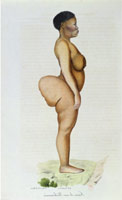Sarah Baartman
Saartjie “Sarah” Baartman (1789 – 29 December 1815) was the most famous of the Khoikhoi women who were exhibited in Europe in the 19th century under the name Hottentot Venus – “Hottentot” the name for the Khoi people and “Venus” in reference to the Venus figurines.
Sarah Baartman to be honoured
 The South African government is to honour Sarah Baartman by establishing the Sarah Baartman Centre of Remembrance, the Sarah Baartman Human Rights Memorial and the Khoi-San Heritage Route at Hankey in the Eastern Cape Province.
The South African government is to honour Sarah Baartman by establishing the Sarah Baartman Centre of Remembrance, the Sarah Baartman Human Rights Memorial and the Khoi-San Heritage Route at Hankey in the Eastern Cape Province.
The Department of Arts and Culture is opening the sites during March, which is Heritage Month, to acknowledge the tribulations and trials of Sarah Baartman and the role that the Khoisan people played in the struggle against colonialism and racism.
The department will also host a series of events, including an academic colloquium at the University of the Western Cape that will focus on issues such as gender oppression, de-humanisation and objectification of women, stereotyping, racism and genocide.
Sarah Baartman, a South African Khoi-San woman, was born in 1789 and worked as a slave in Cape Town when she was discovered by doctor, William Dunlop, from a British ship.
Dunlop persuaded her to travel with him to England where she was captured as a slave and became the object of racism and exploitation.
She was forced to publicly display her unusual physical features and she was subsequently displayed as a scientific curiosity. Her physical characteristics where not unusual for Khoisan women, however to the Europeans her features were larger than normal.
Baartman was later moved to Paris where she continued to be exhibited by an animal trainer in degrading displays for public amusement.
When she died, her body landed under the knife of Baron Cuvier, the leading French anatomist of the day. He had her body cast in wax, dissected and her skeleton articulated. Her genitalia and brain were preserved in a bottle and displayed at the Museum of Mankind in Paris until as recently as 1974.
Return to South Africa
However, a year after the democratic elections in 1994, the new South African government initiated talks with Paris for her remains to be returned.
On 9 August 2002, on Women’s Day, the remains of Sarah Baartman were finally laid to rest at Hankey, the area of her birth near the Gamtoos River Valley in the Eastern Cape Province.
Her grave has since been declared a national heritage site.



